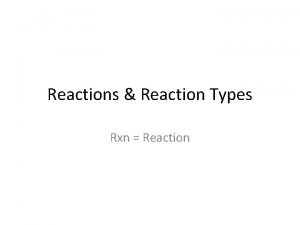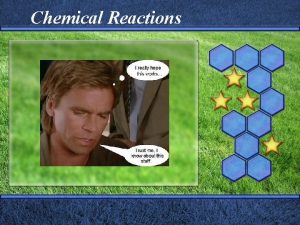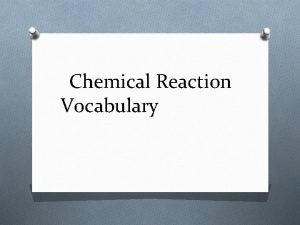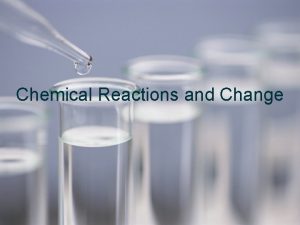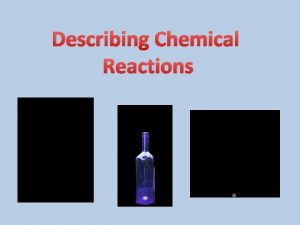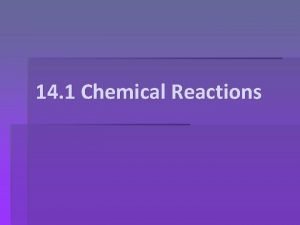Chemical Reactions Chemical Reactions Chemical Reaction process that












- Slides: 12

Chemical Reactions

Chemical Reactions • Chemical Reaction: process that changes one set of chemicals into another set of chemicals • Reactants - elements or compounds entering the reaction • Products - elements or compound formed by the reaction – Break bonds in reactions and form new bonds in products • CO 2 + H 2 O H 2 CO 3 • H 2 CO 3 CO 2 + H 2 O

Energy in Reactions • Chemical reactions can release energy or absorb energy when chemical bonds are formed or broken. • Reactions that release energy occur spontaneously. • Heat, light, or sound • Reactions that absorb energy need a source of energy to begin. • 2 H 2 + O 2 –> 2 H 2 O

Activation Energy • Activation Energy: energy need to start a reaction – Cellulose, in paper, burns in the presence of oxygen and release heat and light, but requires the energy of match to start the reaction. • Catalysts: a substance that speed up the rate of chemical reactions; – Lowers activation energy – Use catalysts when activation energy is too great or reaction is too slow

Ea

Enzymes • Enzymes: protein catalyst that speed up reaction inside cells • Specific: each enzyme only catalyzes only one reaction • Each enzyme has a specific, complex shape • names end in -ase


Enzyme Action • Enzymes provide a site where reactant can come together to react reduces energy need • substrates: reactants of enzymecatalyzed reaction • substrate binds to the active site


Enzyme Action • lock & key: which have complementary shapes • once the substrate binds to the enzyme, it becomes Enzyme-Substrate Complex – they remain bound until the reaction occurs – after which, the products are released – the enzyme can start anew • Regulation of Enzyme Activity – affected by temperature & p. H


Enzyme Animation • http: //www. lpscience. fatcow. com/jwan amaker/animations/Enzyme%20 activit y. html
 Section 2 classifying chemical reactions worksheet answers
Section 2 classifying chemical reactions worksheet answers Chemical reactions section 2 classifying chemical reactions
Chemical reactions section 2 classifying chemical reactions Chemical reactions section 3 reactions in aqueous solutions
Chemical reactions section 3 reactions in aqueous solutions Difference between nuclear reaction and chemical reaction
Difference between nuclear reaction and chemical reaction Phân độ lown
Phân độ lown Block nhĩ thất cấp 1
Block nhĩ thất cấp 1 Thơ thất ngôn tứ tuyệt đường luật
Thơ thất ngôn tứ tuyệt đường luật Thơ thất ngôn tứ tuyệt đường luật
Thơ thất ngôn tứ tuyệt đường luật Chiến lược kinh doanh quốc tế của walmart
Chiến lược kinh doanh quốc tế của walmart Tìm độ lớn thật của tam giác abc
Tìm độ lớn thật của tam giác abc Hãy nói thật ít để làm được nhiều
Hãy nói thật ít để làm được nhiều Tôn thất thuyết là ai
Tôn thất thuyết là ai Gây tê cơ vuông thắt lưng
Gây tê cơ vuông thắt lưng













